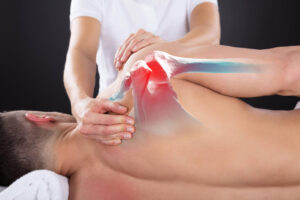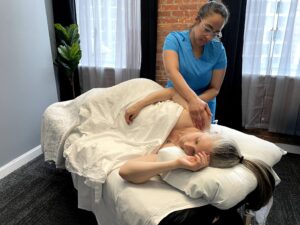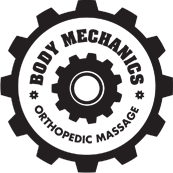Why Side-Lying Massage Is an Essential Skill- And How We Teach Our Therapists
 When most people picture a massage session, they imagine lying face down or face up on the table. But for many clients—especially those with low back pain, post-surgical restrictions, pregnancy, respiratory issues, or mobility challenges—these positions can be uncomfortable, unsafe, or even impossible. That’s where the side-lying position comes in.
When most people picture a massage session, they imagine lying face down or face up on the table. But for many clients—especially those with low back pain, post-surgical restrictions, pregnancy, respiratory issues, or mobility challenges—these positions can be uncomfortable, unsafe, or even impossible. That’s where the side-lying position comes in.
Side-lying isn’t just a “backup plan.” It’s a strategic, highly effective clinical choice that can improve both comfort and results. In this position, the lateral line of the body—think rib cage, obliques, quadratus lumborum, gluteus medius/minimus, tensor fasciae latae (TFL), and the iliotibial band (ITB)—is more accessible for targeted work. Therapists can apply specialized techniques such as skin rolling, cross-fiber friction, and pin-and-stretch while taking advantage of gravity-assisted resistance for active movements like clamshells or bicycles. This allows for deep, focused work with less strain on the client and the therapist.
Why Side-Lying Might Be Chosen
Side-lying positioning can be the best choice when:
-
A client has pain or mobility restrictions that make lying prone or supine uncomfortable.
-
Post-surgical recovery limits pressure on certain areas.
-
Pregnancy requires avoiding prolonged face-up or face-down positioning.
-
Respiratory issues make breathing easier in side-lying.
-
Medical devices, drains, or dressings limit other positions.
-
People with large chests or breast tissue or implants may not be comfortable lying face down.
-
Specific therapeutic goals require better access to the side body, hip stabilizers, or certain spinal segments.
- Side-lying is also great for sports, and lateral movement issues.
When Side-Lying May Not Be the Best Option
While versatile, side-lying isn’t ideal in every case. For example:
-
Clients with acute hip bursitis may find the stretch on the affected area too intense. Or if they, in general, have hip pain when side sleeping.
-
Nerve irritation in certain positions may require “slackening” instead of lengthening tissues.
-
Those with balance or stability concerns may need extra bolstering or prefer other positions.
- Those with a preference for face down treatment. Everyone has an idea of what a ‘good’ massage should be.
Therapists must evaluate each case, considering both comfort and therapeutic goals, before choosing positioning as well as communicate effectively.
Why We Teach This to Our Team Side-lying Massage
At Body Mechanics Orthopedic Massage, we believe that high-quality care comes from ongoing, hands-on learning. It is one of our founding tenets. As you move through our programming, this is a class that will eventually be taught to you. That’s why our therapists receive continuing education in advanced positioning techniques, including side-lying orthopedic massage. They also receive New York State CEUS for their training, and they are paid for it. Our training covers:
-
Bolstering & Spinal Alignment – Supporting the body to avoid strain and maintain neutral posture as well as your comfort.
-
Draping Strategies – Protecting client modesty while giving the therapist full access to target areas. The draping should be tidy, efficient, and well done.
-
Condition-Specific Adaptations – Modifying approach for pregnancy, post-surgery, or chronic pain.
-
Therapist Ergonomics – Using body mechanics to deliver pressure effectively and safely.
-
Active Movement Integration – Incorporating motion for joint mobilization, neuromuscular reeducation, and functional range of motion is ESSENTIAL for sports and rehabilitation. Side-lying is an excellent choice for this.
The Result for You
 When you book with us, you’re not just getting a massage—you’re getting care from a therapist trained to adapt, innovate, and work with precision. Whether you’re recovering from surgery, managing a chronic condition, or simply need a comfortable alternative to traditional positioning, our team is ready to meet you where you are—literally.
When you book with us, you’re not just getting a massage—you’re getting care from a therapist trained to adapt, innovate, and work with precision. Whether you’re recovering from surgery, managing a chronic condition, or simply need a comfortable alternative to traditional positioning, our team is ready to meet you where you are—literally.
You know you’re in good hands when your therapist hears that you feel panicked face down or that you have an issue that needs side body access and they can easily and professionally modify without missing a beat.
Because in our clinic, education isn’t optional. It’s the foundation for every session we give.
